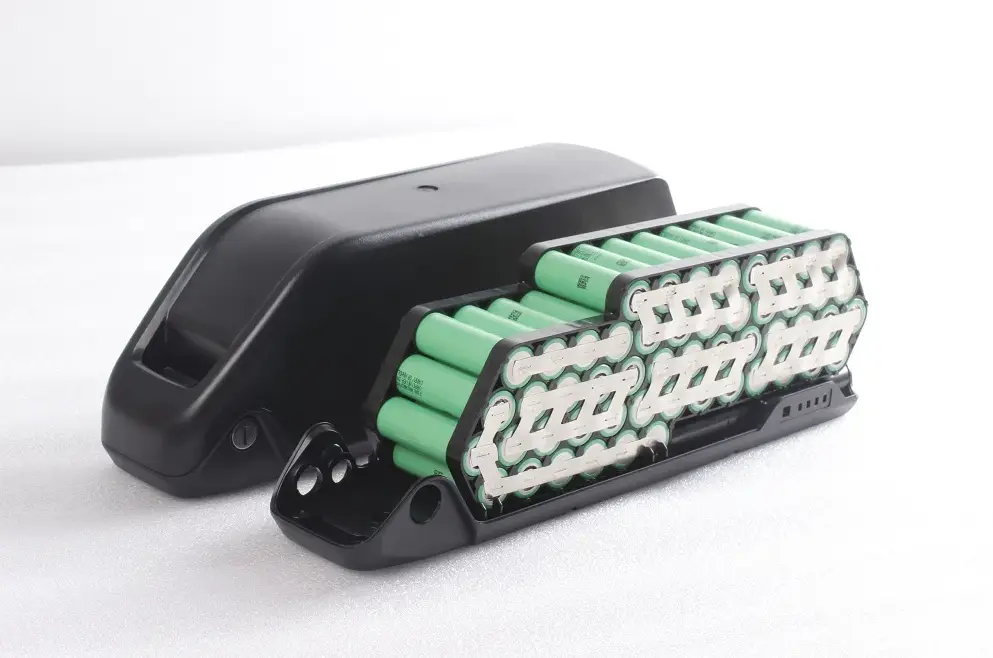”This innovative system makes bicycle mobility accessible to a wide user base and solves...
The Heart of the E-Bike: Understanding Electric Bike Batteries and Safety
The Heart of the E-Bike: Understanding Electric Bike Batteries and Safety

At the core of every electric bike lies a sophisticated piece of technology: the battery.
Think of it as the beating heart of your e-bike. It’s the energy powerhouse that fuels your ride, much like the engine powers a car. Electric bike batteries are designed to store and release electrical energy efficiently, but the battery faces the risk of catching fire.
In the following sections, we’ll explore the various aspects of electric bike batteries, from the common types to the factors affecting their lifespan. Additionally, we’ll provide guidance on selecting fireproof batteries and best practices for their safe use, ensuring that you can fully embrace electric bikes’ benefits without compromising safety.
Types of e-Bike Batteries:
Lead-Acid Batteries
These were among the earliest batteries used in e-bikes, and while they’re affordable, they’re pretty heavy and have a limited lifespan. Lead-acid batteries store energy through a chemical reaction between lead dioxide and sulfuric acid. When you engage the motor, this stored chemical energy is converted into electrical energy, propelling the bike.
Lithium-Ion Batteries
Lithium-ion batteries have become the gold standard for e-bikes due to their high energy density, light weight, and longer lifespan. They store energy by moving lithium ions between the positive and negative electrodes. When you pedal or engage the motor, these ions are set into motion, creating an electric current that powers the bike.
Nickel-Cadmium (NiCd) Batteries
Although less common today, NiCd batteries were once used in e-bikes. They have a decent energy density but are susceptible to the memory effect, which can reduce their capacity over time. NiCd batteries store energy by moving nickel and cadmium ions between electrodes, releasing energy when needed for propulsion.
Nickel-Metal Hydride (NiMH) Batteries
NiMH batteries offer a middle ground between lead-acid and lithium-ion batteries. They are more environmentally friendly than NiCd batteries and provide moderate energy density. Like their NiCd counterparts, these batteries store energy by shuttling metal hydride ions between electrodes.
The Energy Storage and Release Process
At its core, this is a chemical reaction. When you charge your e-bike battery, electrical energy from an external source, such as a charger, is converted into chemical energy. This energy is stored within the battery’s cells as potential energy, ready to be unleashed.
When you pedal your e-bike or engage the motor, a controller determines how much energy is needed to assist your ride. It then releases this stored chemical energy, converting it back into electrical energy. This electrical energy powers the motor, which, in turn, propels the bike forward.
Battery Capacity and Range: Unraveling the Connection
Put simply, battery capacity directly impacts how far you can travel on a single charge.
Higher Capacity, Longer Range: E-bike batteries with higher capacity store more energy. As a result, they can power the bike for longer distances before requiring a recharge.
Lower Capacity, Shorter Range: Conversely, lower-capacity batteries have less stored energy and provide a shorter riding range on a single charge.
For example, e-bikes used for food delivery, where frequent stops and longer hours of operation are common, often need high-capacity batteries so riders can cover distances without stopping for a recharge.
City commuter e-bikes, on the other hand, only need moderate capacity.
In essence, selecting the suitable battery capacity depends on your specific needs and usage patterns. It’s best to analyse your intended riding distance to determine the right battery size for your organisation.
What Affects e-Bike Battery Lifespan?
While the quality of the battery is a significant factor, it’s important to maintain it correctly. The most essential factors affecting your e-bike’s battery lifespan include the following:
- Charging habits: Your battery will degrade faster if you frequently discharge it deeply or overcharge it.
- Temperature: Batteries are sensitive to extreme heat or cold.
- Usage patterns: If you ride the bike aggressively or use it at high speeds or heavy loads, the battery will strain more.
- Storage: If you store the e-bike with a full or empty battery for a long time without use, its battery will decay faster.
- Quality and maintenance.
- The battery’s overall number of charge and discharge cycles.
- Overvoltage.
- Age.
The Vital Role of Fireproof Electric Bike Batteries in Ensuring Safety
According to the latest information, as of July 3, 2023, there have been 114 investigations into lithium-ion fires, 74 injuries and 13 deaths. These incidents may occur due to manufacturing defects, physical damage, overcharging, or contaminants within the battery.
And while we don’t see e-bikes on fire everywhere we look, you have to recognise that even isolated cases result in severe consequences: injuries, property damage, and liabilities.
Thankfully, researchers have designed fireproof e-bike batteries.
How Do Fireproof Batteries Help?
Fireproof electric bike batteries are engineered with safety as the top priority. They employ advanced technology and materials to mitigate fire risks, including:
- Fireproof batteries incorporate sophisticated thermal management systems that monitor and control temperature levels, preventing overheating.
- The chemistry of fireproof e-bike batteries is designed to be more stable, reducing the likelihood of thermal runaway—a condition where a battery generates excessive heat uncontrollably.
- The battery’s outer casing is fire-resistant, acting as a barrier to contain any potential fires, preventing them from spreading and minimising damage.
These design features collectively reduce the risk of battery fires, which makes them a reliable choice for businesses that use e-bikes daily.
Enhanced Rider Safety with Fireproof Batteries
When you opt for fireproof electric bike batteries, you opt for driver safety. Unlike traditional batteries that may catch fire, fireproof batteries minimise the risk of accidents caused by battery malfunctions and provide a more secure riding experience.
For businesses operating e-bike fleets, adopting fireproof batteries means reduced risks of costly e-bike damage, potential liabilities, and operational interruptions.
If your business is electric, your batteries need to be fireproof.
Best Practices for Choosing and Safely Using Fireproof Electric Bike Batteries
Selecting E-Bikes with Fireproof Batteries
When choosing an electric bike equipped with a fireproof battery, make sure you thoroughly audit safety and performance:
- Opt for well-established e-bike manufacturers known for producing quality and safety-focused products.
- Look for e-bikes with batteries certified to meet industry safety standards and regulations.
- Check if the e-bike’s battery management system includes safeguards like thermal monitoring, overcharge protection, and short-circuit prevention.
- Read reviews and seek feedback from other e-bike users and organisations.
How to Minimise Fire Risk with Safe Charging Practices
- Always use the manufacturer’s charger or a reputable replacement.
- Charge your e-bike in a well-ventilated area away from flammable materials and heat sources.
- Unplug the charger once the battery is fully charged.
- Periodically inspect the charger and its cables for damage.
- Charging in extreme temperatures, whether too hot or cold, can harm the battery. Aim for moderate temperature conditions during charging.
- Store your e-bikes in a dry, cool place, ideally at room temperature and avoid long-term storage with a fully discharged or fully charged battery.
A little maintenance goes a long way towards a safe riding experience and a longer e-bike battery lifespan!
Mitigate Risks – Drive Safe
When your e-bikes enable you to run your business, mitigate every possible risk. Batteries are necessary for operating an electric bike, but that doesn’t mean you have to shoulder the risks yourself.
Opt for a fireproof e-bike battery instead. With sophisticated thermal management systems, reduced likelihood of thermal runaway, and sturdy outer casing, fireproof batteries are designed to keep malfunctions to a minimum and provide your organisation with a smoother, more secure riding experience.
Share On
Related Articles
FREENOW partners with MOBY to offer in-app bookings in Dublin
Today, we're delighted to announce our partnership with MOBY, which will integrate their fleet...

